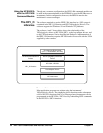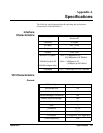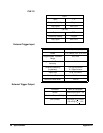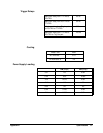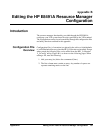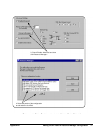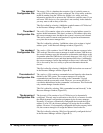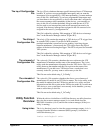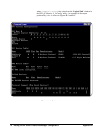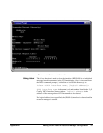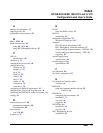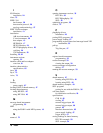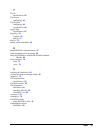
72 Editing the HP E8491A Resource Manager Configuration Appendix B
The names.cf
Configuration File
The names.cf file is a database that contains a list of symbolic names to
assign VXI devices that have been configured. The ivxirm utility reads the
model id number from the VXI device and the ivxisc utility uses that
information and this file to print out the VXI device symbolic name. If you
add a new VXI device to your system that is not currently in the database,
you may want to add an entry to this file.
This file is edited by selecting “Add/delete symbolic names of VXI devices”
in the Resource Manager window (Figure B-2).
The oride.cf
Configuration File
The oride.cf file contains values to be written to logical address space for
register-based instruments. This data is written to A16 address space after
the resource manager runs, but before the system’s resources are released.
This can be used for custom configuration of register-based instruments
every time the resource manager runs.
This file is edited by selecting “Add/delete values to be written to logical
address space” in the Resource Manager window (Figure B-2).
The vmedev.cf
Configuration File
The vmedev.cf file contains a list of VME devices that use resources in the
VXI cardcage. Since the resource manager is unable to detect VME devices,
the resource manager uses this information to determine such things as the
slot number where the VME device is located, what type (A16, A24, or A32)
and how much memory it uses, and what interrupt lines it uses. Additionally,
the resource manager verifies that multiple resources aren’t allocated. This
file is also used by the ivxisc utility to print out information about the
devices.
This file is edited by selecting “Add/delete VME devices that use resources”
in the Resource Manager window (Figure B-2).
The cmdrsrvt.cf
Configuration File
The cmdrsrvt.cf file contains a commander/servant hierarchy other than the
default for the VXI system. The resource manager will set up the
commander/servant hierarchy according to the commander’s logical
addresses and the servant area switch. However, you can use this file to
override the default based on the commander’s servant area. This file should
only contain changes from the default.
This file is edited by selecting “Edit commander/servant hierarchy” in the
Resource Manager window (Figure B-2).
The dynamic.cf
Configuration File
The dynamic.cf file contains a list of VXI devices to be dynamically
configured. You only need to add entries to this file if you want to override
the default dynamic configuration assignment by the resource manager.
Normally, if you have a dynamically configurable device and the logical
address is set at 255, the resource manager will assign the first available
address. However, if a dynamically configurable device has an entry in this
file, the resource manager will assign the address listed in the file.
This file is edited by selecting “Edit list of dynamically configured devices”
in the Resource Manager window (Figure B-2).



